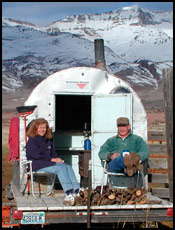
Ron Torell with his wife, Jackie.
Cow Camp Chatter
Short-term cows
For years our industry has referred to spent cows as culls. This is perhaps a poor choice of words used to describe market-ready animals. As beef producers, each of us has the responsibility to recognize when it is time to send a cow to market. The industry cannot tolerate the marketing of shelly, weak and down cows.
In an effort to capitalize on the best calf market the beef industry has ever experienced, many cattlemen are looking at ways to economically expand their 2012 brood cow inventory. One option is to defer issuing pink slips to the experienced veterans of the herd — those pregnant, smooth-mouthed cows who are 10 years old and beyond. These senior bovine employees have already proven themselves, yet they are past their prime largely due to their age and lack of teeth.
Squeezing that last calf out of an old cow does not work in every case. It may, however, if you apply a few basic management principles.
With old cows, consumption and feed efficiency decrease while nutrient requirements remain the same. A properly functioning ruminant digestive system is dependent on small particle sizes of feedstuffs. Mechanical breakdown of feedstuffs requires a full mouth of teeth, which are often absent in these older animals. In the absence of teeth, the particle size of consumed feedstuffs is increased. As a result, passage rate is slowed and consumption reduced.
In addition, many of these old cows have lost some of the villi in the lining of their digestive tracts. The combination of these two issues requires that these cows be placed on a nutrient-dense ration that is softer in texture and smaller in particle size.
Cows living and producing past their prime are usually worn out and need all the help we can give them in order for them to produce their last calf. For this reason, a winter ration that is high in protein and energy is ideal for the older cow. An example of a nutrient-dense ration may include chopped hay with a concentrate or one of the inexpensive, softer vegetable-matter byproduct feeds.
It is also important to take into account that many of the vital organs of the older cow may not be running at peak performance. For this reason they will often benefit from a micro-mineral package and administration of a type 2 deworming product.
In every herd of cows, the pecking order, or chain of command, is well-established. Never winter-feed the short-term cows with the main bunch. Consider winter-feeding these old cows separately or with the younger group that has a higher nutrient demand. Some of these old cows have had their way for more than 10 years, so allow plenty of bunk space to compensate for the "boss cow" hierarchy. If feeding on the ground, feed over a large area so the older cows can have their share.
It's important to do your homework when making the decision to short-term your older bovine employees. Short-terming works best in years when fall market-ready cow prices and feed costs are low and there is a good probability of relatively high calf and market-ready cow prices the following year. In contrast, given the high feed costs and cow prices we are currently experiencing, this scenario may not work unless you have access to inexpensive feed required by this class of livestock.
Be very selective on the cows you short-term. Some cows are depleted and will not produce under any circumstances. Short-term candidates need to be pregnant to calve early, stand structurally correct and strong, and must be able to travel. Make sure their mammary system is still functional, having no bottle teats or blown-out bags.
Given today's high feed costs, avoid those cows that are extremely thin and weak. Flesh cannot be economically returned once it is lost. Issue the pink slip immediately to those cows that have already turned the corner. They are a poor risk. Timely marketing of market-ready cows is the right thing to do.
Taking advantage of the late-summer, market-ready superior cow market will often pay for the extra feed and care required to get that extra calf. An option employed by many ranchers is to overwinter their old March-calving cows on the ration previously discussed. They will then graze the cow-calf pairs inside on quality pasture in the spring and early summer. After weaning the calves at about 170-days of age, the old cow is then immediately sold.
Quantity has a quality all its own. This certainly holds true when it comes to short-term cows. A smooth-mouthed pregnant cow often brings a small premium over market-ready rail prices. If you are not willing or able to follow the management suggestions made in this article, perhaps you are better off to haul the old-timers to town and let someone else with the necessary resources put together the quantity of short-term cows to make it work.
That's enough for this month. A special thanks to my wife, Jackie, for her part in writing "Cow Camp Chatter." As always, if you would like to discuss this article or simply want to talk cows, do not hesitate to contact me at 775-385-7665 or e-mail me.











